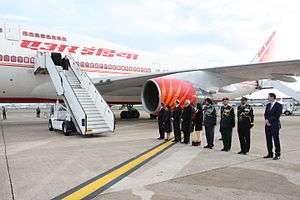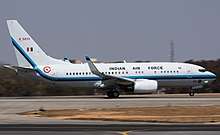Air India One
Air India One (also referred to as AI-1[1] or AIC001) is the call sign of any aircraft with the President or Prime Minister of India on board. Air India is the national airline of India.[2] The aircraft is operated as VVIP flight by the Indian Air Force (IAF).[3] The IAF's Air Headquarters Communication Squadron, based at Indira Gandhi International Airport (formerly Palam Air Force Base) in New Delhi, is in charge of operating these aircraft.[4]

Current fleet
Apart from the Boeing 747-400s owned by Air India and used on international state visits, the IAF currently owns four 14 seater Embraer 135, four 20 seater Embraer 145 and three customised 46 seater Boeing Business Jets (BBJ) that have a VIP cabin and are used for VIP movement. Of these the Boeing 747s are used by either the Prime Minister, President or Vice-President when on official overseas visits.[4][5]
Each Embraer 135 is equipped with missile-deflecting systems, modern flight management system including global positioning system, as well as category II instrument landing system. These aircraft cost the IAF ₹14 billion (US$200 million) each.[5] The Three BBJs, named Rajdoot, Rajhans and Rajkamal cost the IAF ₹93.4 billion (US$1.3 billion) each (₹73.4 billion (US$1.0 billion) for the actual aircraft plus an additional ₹20 billion (US$280 million) for Self Protection Suites).[3][4] Self-protection suites include radar warning receivers, it also has highly trained commandos to protect the president/vice/prime minister, missile-approach warning and counter-measure systems. The aircraft has the capability to shoot chaff and flares to deviate radar-guided and heat-seeking missiles off their track along with other security tools. The other security instruments are undisclosed by the Indian Air Force.
The onboard electronics include about 238 miles of wiring (twice the amount found in a normal 747). Heavy shielding is tough enough to protect the wiring and crucial electronics from the electromagnetic pulse associated with a nuclear blast.
The President is designated VIP 1, The Vice-President, VIP 2, and The Prime Minister, VIP 3. The BBJs have a four class configuration. For the President/Prime Minister, there is a separate enclosure in the aircraft which includes an office and a bedroom. Everyone aboard Air India One is required to wear a colour-coded identity card. Members of the official delegation (Joint Secretary level and above) are tagged in purple and sit in First Class while accompanying the VIPs. As they have become less cost-effective to operate, the Indian Air Force is looking forward to replacing the present Boeing 747-400 with the Boeing 777-300ER. The committee is soon to take the call. The planes will be maintained by the Indian Air Force.[1]
Replacements

Before the successor to the original B-747 is found, a panel of secretaries of top ministries like defence, finance, aviation, external affairs, home along with brass of the Special Protection Group (SPG) will meet to address two key issues – whether the new plane should be two-engine or four-engine and whether AI or Indian Air Force should be operating and maintaining the plane. [6]

The IAF maintains and operates a fleet of Boeing Business Jets for use by top VVIPs like President, Vice-President and Prime Minister for flying within India and to neighbouring countries. "The secretaries will decide whether the new aircraft should be with AI or IAF. If they decide in favour of the IAF, then the defence establishment will decide the successor aircraft. Else, civil aviation authorities will take a technical call on which plane is best suited for the VVIPs," said the source. The final decision will be taken by the highest echelons of the government. However given the long-distance requirement, the choice for both the defence and civil aviation authorities is going to be limited to the options from Boeing and Airbus.[7]
The government has chosen the ultra long-haul Boeing 777-300ER to replace the ageing Boeing 747s that serve as the Air India One fleet.
In 2006, Air India had placed orders with Boeing for 68 aircraft — 27 Dreamliners, 15 B777-300 ERs, eight B777-200 LRs and 18 B737-800s. Of these, the state-run carrier has already taken the delivery of 65 planes, including 12 B777-300ERs. Remaining three B777-300 ERs are to be handed over to Air India on January 24 2018.“These planes, however, will go back to the US for modification, which will take at least a year to complete,”.[8]
In a significant departure from the past and on the lines of the US President's Air Force One fleet, the two 777s once handed over to the defence ministry won't be used for commercial operations by AI at all. At present, the 747s are deployed for commercial operations by AI when not in use for VVIP flights.
According to discussions, the government will buy out the two planes from AI, sources said.
Two custom-made Boeing 777 planes, which will be used to fly Prime Minister Narendra Modi and other top Indian dignitaries from July next year, will be operated by pilots of the Indian Air Force and not of Air India. However, the new wide-body planes will be maintained by Air India Engineering Services Limited (AIESL), which is a subsidiary of the Indian national carrier[9]
Security Upgrade
The government of India has requested to buy two SPS consisting of LAIRCM Advanced Integrated Defensive Electronic Warfare Suite, Counter-Measures Dispensing System (CMDS) to protect two Boeing-777-300ER (white colour livery)
Head-of-State aircraft. This potential sale would include: twelve guardian laser transmitter assemblies… missile warning sensors.. counter-measures dispensing system..," the Defence Security Cooperation Agency (DSCA), that comes under the US department of defence, said in a statement, adding, "Also included in this sale are Advanced Integrated Defensive Electronic Warfare Suites…"
Indian Air Force One (if AI if privatised) aircraft will be equipped with "large aircraft infrared countermeasures (LAIRCM) self-protection suites (SPS) for an estimated cost of $190 million”. The US State Department has approved the 'foreign military sale' of two B777 LAIRCM SPS.[10]
Boeing had delivered the two B777 300 extended range (ER) to Air India in January 2018. The airline sent these two to Fort Worth in Dallas last summer for being retrofitted with the latest security and communication systems so that they can replace the over 26-year-old jumbo jets used by the president, VP and PM for long international flights. The two are with Boeing Defence for retrofitting with the latest security and communication systems. The two planes are expected to be in India by July 2020.
See also
- Air Force One - Official aircraft of the President of the United States of America
- Japanese Air Force One - Official presidential aircraft (currently two Boeing 777-300) of Japan
- Russian presidential aircraft
- Air transports of heads of state and government
References
| Wikimedia Commons has media related to Air India One. |
- "Air India One, Seat No 59G". 26 September 2010. Retrieved 9 April 2011.
- "Manmohan Singh to travel in Air India One Agra". Topnews.in. Retrieved 9 April 2011.
- "April 1 date for President with business jets". Zee News. 16 March 2009. Archived from the original on 7 May 2012. Retrieved 8 April 2011.
- "India's own Air Force One takes to the skies". The Hindu. 1 April 2009. Archived from the original on 26 September 2011. Retrieved 9 April 2011.
- "VVIPs get their special jets". 21 September 2005. Retrieved 8 April 2011.
- "New take-off: Boeing 777s to replace 747s in PM's Air India One fleet". 15 April 2015.
- "Centre hunts for replacement of PM Narendra Modi's VIP plane - Times of India". Retrieved 1 December 2018.
- "Air India to take delivery of B777 plane on January 24". The Financial Express. 12 January 2018. Retrieved 27 May 2020.
- "IAF pilots to fly Modi on new 'Air India One' from next July". The Week. Retrieved 27 May 2020.
- "Upcoming Air India One to get massive security overhaul - Flying fortress". The Economic Times. Retrieved 27 May 2020.